43 found, showing page 1 of 3
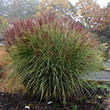
Copper red blooms late summer through winter. Narrow foliage with white margins. USDA 5-9
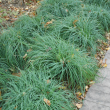
Height: 8 inches
Spread: 12 inches
Sunlight: partial shade, full shade
Hardiness Zone: 3a
Other Names: Oak Sedge
Description:
This shade loving native sedge features soft, arching semi-evergreen foliage; excellent in rock gardens, containers, or as a groundcover; prefers part shade and dry to medium moisture; tough and adaptable
Ornamental Features:
Pennsylvania Sedge is primarily valued in the garden for its cascading habit of growth. Its grassy leaves remain forest green in color throughout the season.
Landscape Attributes:
Pennsylvania Sedge is an herbaceous perennial grass with a shapely form and gracefully arching stems. It brings an extremely fine and delicate texture to the garden composition and should be used to full effect.
This is a relatively low maintenance plant, and is best cleaned up in early spring before it resumes active growth for the season. It has no significant negative characteristics.
Pennsylvania Sedge is recommended for the following landscape applications:
- Mass Planting
- Rock/Alpine Gardens
- Border Edging
- General Garden Use
- Groundcover
- Container Planting
- Planting & Growing
Pennsylvania Sedge will grow to be about 8 inches tall at maturity, with a spread of 12 inches. Its foliage tends to remain low and dense right to the ground. It grows at a slow rate, and under ideal conditions can be expected to live for approximately 10 years. As an herbaceous perennial, this plant will usually die back to the crown each winter, and will regrow from the base each spring. Be careful not to disturb the crown in late winter when it may not be readily seen!
This plant does best in partial shade to shade. It prefers to grow in average to dry locations, and dislikes excessive moisture. It is not particular as to soil type or pH. It is somewhat tolerant of urban pollution. Consider applying a thick mulch around the root zone in both summer and winter to conserve soil moisture and protect it in exposed locations or colder microclimates. This species is native to parts of North America. It can be propagated by division.
Pennsylvania Sedge is a fine choice for the garden, but it is also a good selection for planting in outdoor pots and containers. It is often used as a 'filler' in the 'spiller-thriller-filler' container combination, providing the canvas against which the thriller plants stand out. Note that when growing plants in outdoor containers and baskets, they may require more frequent waterings than they would in the yard or garden.
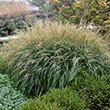
'Adagio' Maiden Grass | Pinkish blooms. Upright clumping grass. Self-seeding. USDA 5-9
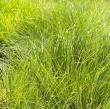
Height: 6 inches
Spread: 18 inches
Sunlight: partial shade full shade
Hardiness Zone: 3a
Description:
A weeping, perennial native sedge that forms graceful, mounded tufts of very fine textured, deep green, threadlike foliage; thrives in dry to mesic woods and does best with some shade; perfect for massing, slopes, or as a shade groundcover
Ornamental Features:
Appalachian Sedge is primarily valued in the garden for its cascading habit of growth. Its attractive threadlike leaves remain forest green in color throughout the season.
Landscape Attributes:
Appalachian Sedge is an herbaceous perennial grass with a shapely form and gracefully arching stems. It brings an extremely fine and delicate texture to the garden composition and should be used to full effect.
This is a relatively low maintenance plant, and is best cleaned up in early spring before it resumes active growth for the season. It has no significant negative characteristics.
Appalachian Sedge is recommended for the following landscape applications:
- Mass Planting
- Rock/Alpine Gardens
- Border Edging
- Groundcover
- Naturalizing And Woodland Gardens
- Container Planting
Planting & Growing:
Appalachian Sedge will grow to be only 6 inches tall at maturity, with a spread of 18 inches. Its foliage tends to remain low and dense right to the ground. It grows at a medium rate, and under ideal conditions can be expected to live for approximately 10 years. As an herbaceous perennial, this plant will usually die back to the crown each winter, and will regrow from the base each spring. Be careful not to disturb the crown in late winter when it may not be readily seen!
This plant does best in partial shade to shade. It prefers to grow in average to dry locations, and dislikes excessive moisture. It is considered to be drought-tolerant, and thus makes an ideal choice for a low-water garden or xeriscape application. This plant should not require much in the way of fertilizing once established, although it may appreciate a shot of general-purpose fertilizer from time to time early in the growing season. It is not particular as to soil type or pH. It is somewhat tolerant of urban pollution. This species is native to parts of North America. It can be propagated by division.
Appalachian Sedge is a fine choice for the garden, but it is also a good selection for planting in outdoor pots and containers. It is often used as a 'filler' in the 'spiller-thriller-filler' container combination, providing a canvas of foliage against which the thriller plants stand out. Note that when growing plants in outdoor containers and baskets, they may require more frequent waterings than they would in the yard or garden.
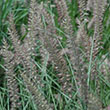
Dark, smoky rose-purple flower spikes. Deep green arching foliage. USDA 5-8
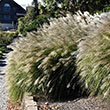
Copper red blooms. Narrow green foliage. Arching clump. USDA 5-9
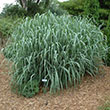
White, feathery plumes are tinged with purple. Rich-green foliage. USDA 5-9
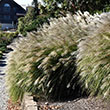
Copper red blooms. Narrow green foliage. Arching clump. USDA 5-9
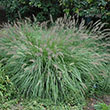
Tan bottlebrush blooms. Arching dark green foliage. Mounding. USDA 6-9
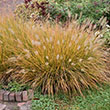
White blooms. Compact. Clumping green foliage. USDA 5-9
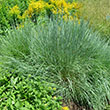
Upright clumps of slender, flat, linear bluish green leaves. Purplish-bronze blooms. Tolerates black walnut. USDA 3-9
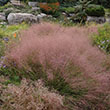
Airy reddish-pink blooms. Fine textured foliage. USDA 5-10
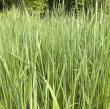
Height: 5 feet
Spread: 32 inches
Sunlight: full sun, partial shade
Hardiness Zone: 3a
Other Names: Feather Reed Grass
Description:
Dramatic red-copper plumes are eye catching during the early to mid summer months; a cool weather performer that looks wonderful in fresh or dried flower arrangements, borders or garden landscapes; heat tolerant and low maintenance
Ornamental Features:
Karl Foerster Reed Grass is primarily grown for its highly ornamental fruit. The tan seed heads are carried on showy plumes displayed in abundance from late summer to late winter. It features bold plumes of brick red flowers with coppery-bronze overtones rising above the foliage in mid summer. Its grassy leaves are green in color. The foliage often turns tan in fall. The gold stems can be quite attractive.
Landscape Attributes:
Karl Foerster Reed Grass is an herbaceous perennial grass with an upright spreading habit of growth. It brings an extremely fine and delicate texture to the garden composition and should be used to full effect.
This plant will require occasional maintenance and upkeep, and is best cut back to the ground in late winter before active growth resumes. It has no significant negative characteristics.
Karl Foerster Reed Grass is recommended for the following landscape applications:
- Vertical Accent
- Mass Planting
- General Garden Use
- Groundcover
- Naturalizing And Woodland Gardens
- Container Planting
Planting & Growing:
Karl Foerster Reed Grass will grow to be about 4 feet tall at maturity, with a spread of 32 inches. It tends to be leggy, with a typical clearance of 1 foot from the ground, and should be underplanted with lower-growing perennials. It grows at a medium rate, and under ideal conditions can be expected to live for approximately 10 years. As an herbaceous perennial, this plant will usually die back to the crown each winter, and will regrow from the base each spring. Be careful not to disturb the crown in late winter when it may not be readily seen!
This plant does best in full sun to partial shade. It is very adaptable to both dry and moist locations, and should do just fine under typical garden conditions. It is not particular as to soil type or pH. It is highly tolerant of urban pollution and will even thrive in inner city environments. This particular variety is an interspecific hybrid. It can be propagated by division; however, as a cultivated variety, be aware that it may be subject to certain restrictions or prohibitions on propagation.
Karl Foerster Reed Grass is a fine choice for the garden, but it is also a good selection for planting in outdoor pots and containers. With its upright habit of growth, it is best suited for use as a 'thriller' in the 'spiller-thriller-filler' container combination; plant it near the center of the pot, surrounded by smaller plants and those that spill over the edges. It is even sizeable enough that it can be grown alone in a suitable container. Note that when growing plants in outdoor containers and baskets, they may require more frequent waterings than they would in the yard or garden.
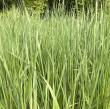
Upright. Pink-purple feathery summer blooms. Prefers moist soils. Tolerates clay and sandy soils. USDA 5-9
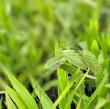
Height: 5 feet
Spread: 30 inches
Sunlight: full sun, partial shade
Hardiness Zone: 4a
Other Names: Uniola latifolia
Description:
This grass is grown for its lovely drooping hop-like seed heads that flutter in the wind; the seed heads mature to a purple-bronze color and make a nice accent when left on through the winter; use for fresh and dried flower arrangements
Ornamental Features:
Northern Sea Oats is primarily grown for its highly ornamental fruit. It produces abundant clusters of purple hop-like fruit from late summer to late fall. It grassy leaves are light green in color. As an added bonus, the foliage turns a gorgeous coppery-bronze in the fall.
Landscape Attributes:
Northern Sea Oats is an herbaceous perennial grass with a shapely form and gracefully arching stems. Its medium texture blends into the garden, but can always be balanced by a couple of finer or coarser plants for an effective composition.
This is a relatively low maintenance plant, and is best cleaned up in early spring before it resumes active growth for the season. It has no significant negative characteristics.
Northern Sea Oats is recommended for the following landscape applications:
- Accent
- Mass Planting
- Border Edging
- General Garden Use
- Naturalizing And Woodland Gardens
- Container Planting
Planting & Growing:
Northern Sea Oats will grow to be about 4 feet tall at maturity, with a spread of 30 inches. Its foliage tends to remain dense right to the ground, not requiring facer plants in front. It grows at a medium rate, and under ideal conditions can be expected to live for approximately 10 years. As an herbaceous perennial, this plant will usually die back to the crown each winter, and will regrow from the base each spring. Be careful not to disturb the crown in late winter when it may not be readily seen!
This plant does best in full sun to partial shade. It is quite adaptable, prefering to grow in average to wet conditions, and will even tolerate some standing water. It is not particular as to soil type or pH. It is somewhat tolerant of urban pollution. This species is native to parts of North America.
Northern Sea Oats is a fine choice for the garden, but it is also a good selection for planting in outdoor pots and containers. Because of its height, it is often used as a 'thriller' in the 'spiller-thriller-filler' container combination; plant it near the center of the pot, surrounded by smaller plants and those that spill over the edges. It is even sizeable enough that it can be grown alone in a suitable container. Note that when growing plants in outdoor containers and baskets, they may require more frequent waterings than they would in the yard or garden.
43 found, showing page 1 of 3